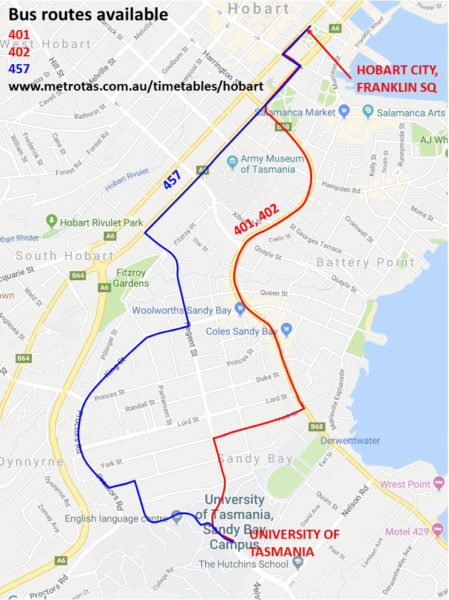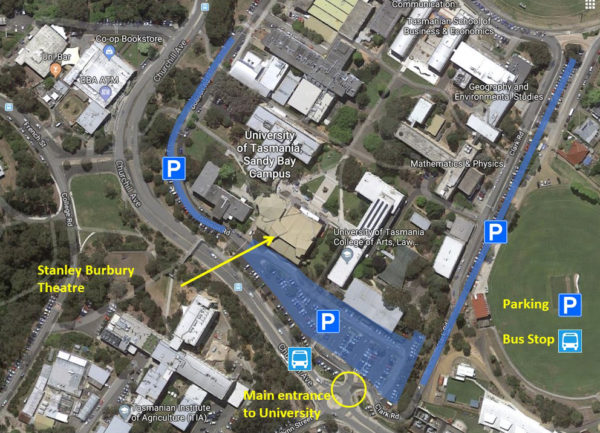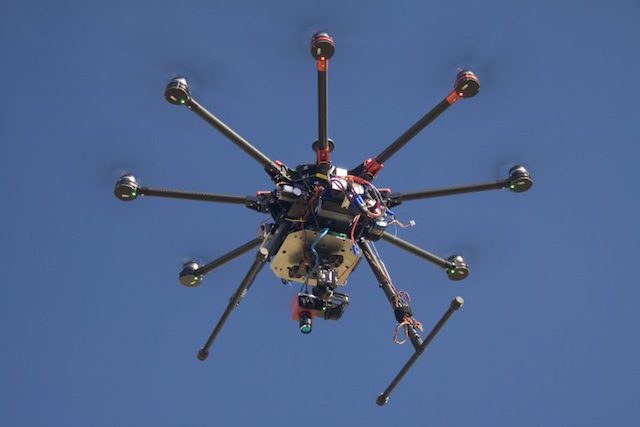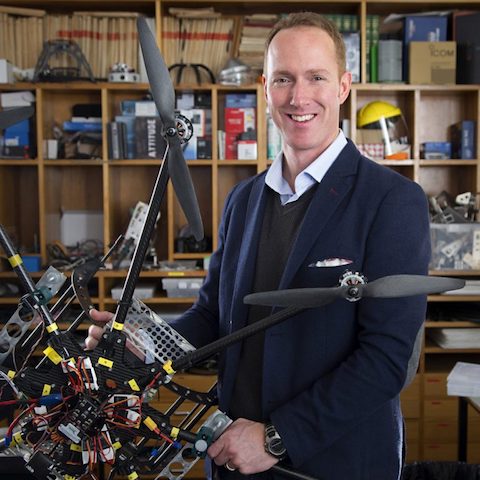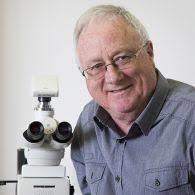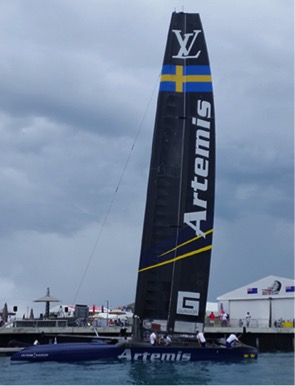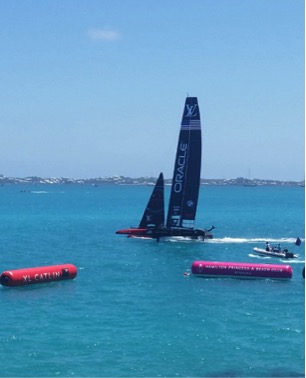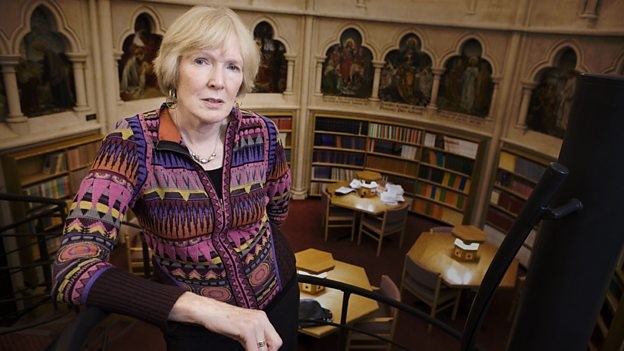Dinosaur Symposium 23-24 March 2019
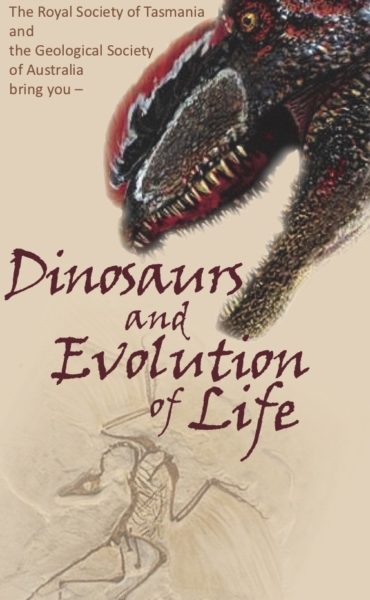 A Symposium: Dinosaurs and Evolution of Life.
A Symposium: Dinosaurs and Evolution of Life.
Hobart, Tasmania
23-24th March 2019
Supported by The Royal Society of Tasmania, Geological Society of Australia (Tas. Div.) and The University of Tasmania
∞
Come along from 8.15am on Saturday or Sunday morning to register for full day or morning sessions.
∞
DOWNLOAD THE Symposium brochure HERE
∞
The Organizing and Scientific Committee of DEL2019, invites you to participate in a 2 day symposium to highlight recent advances in understanding the evolution of life on Earth, with a focus on Dinosaurs.
The conference is organized by The Royal Society of Tasmania as part of their 175thAnniversary celebrations, with support from the Tasmanian Division of the Geological Society of Australia and the University of Tasmania. The venue is the Stanley Burbury Theatre, University of Tasmania, Churchill Avenue, Hobart. (Scroll down for directions to the venue).
The Symposium will run in parallel with an exhibition at the Tasmanian Museum and Art Gallery (TMAG) called “Dinosaur rEvolution; Secrets of Survival” prepared by Gondwana Studios.
Themes of Symposium
-
Recent research on dinosaurs
-
Evolution of dinosaurs and birds
-
Proterozoic evolution of life
-
Phanerozoic evolution of life
-
Mass extinction events
The Royal Society of Tasmania has put together a once-in-a-lifetime program of talks on the latest discoveries about dinosaurs and evolution. We have invited the top dinosaur experts from around Australia to present their recent research on these amazing animals that lived for 165 million years on Earth. You will also hear the latest theories on evolution of the species and the discoveries that Charles Darwin made when he visited Tasmania in 1836.
Participants will benefit from hearing Plenary Session Keynote talks by several distinguished scientists on dinosaurs, evolution and mass extinction.
-
Professor John Long – Flinders University, will give an overview on the origin of the species, including dinosaurs.
-
Dr Steve Salisbury – University of Queensland Dinosaur Lab, will talk about the recent discovery of dinosaur tracks in northwest Western Australia.
-
Dr Stephen Poropat – Swinburne University of Technology will talk about Australian dinosaurs through the Mesozoic period and the Triassic fossils found in the Hobart area – _are they dinosaurs?
-
Dr Phil Bell – University of New England, will talk on recent opalized dinosaur discoveries from Lightning Ridge, NSW.
-
Professor Ross Large – University of Tasmania, will talk about research on past ocean chemistry, evolution and mass extinctions over the last 600 million years.
-
John Pickell – a well-known author has published several books on dinosaurs will run a Q & A session on dinosaurs, fielding all sorts of questions from the audience.
go to … SPEAKERS FOR THE DINOSAUR SYMPOSIUM for more
PROGRAM
Symposium on Dinosaurs and Evolution of Life
The Royal Society of Tasmania and GSA Tasmanian Division
The morning program is designed for the general public, educationists and students older than 10 years, interested scientists and young aspiring scientists. It is delivered by experts in their field.
The afternoon program is more technical in nature, mainly for geoscientists and biologists, but will be of interest to others wanting to learn more about dinosaurs, dinosaur art and evolution.
Further information from the Royal Society of Tasmania website or Convenor – Professor Ross Large 0418352501 or the Hon. Secretary David Wilson 0409854101.
©
Saturday 23rd March
Morning Session – General public, students above 10 years and scientists
Chair: Prof Ross Large (Royal Society of Tasmania)
9.00 – 9.15 Welcome & Introduction
9.15 – 9.45 Why evolution matters – reflections on deep time and the history of life – Prof John Long
9.45- 10.15 The story of Early Complex life before Dinosaurs – Dr Indrani Mukherjee
10.15-10.45 Morning Tea – appearance of Rosie and Rex Dinosaur replicas
10.45- 11.15 Australia’s Dinosaurs and their World – Dr Stephen Poropat
11.15 – 11.45 Exciting Dinosaur Trackway Discoveries from Kimberley region, WA – Dr Steve Salisbury
11.45 – 12.15 Dinosaur expert panel Q & A
12.15 – 1.30 Lunch (provided free for those with a full day or 2 day ticket)
Afternoon session – aspiring scientists, geoscientists and biologists
Chair: Dr Karen Orth (GSA Tas. Div.)
1.30-2.00 Spectacular Dinosaur Trackways from South Korea – Andy Spate
2.00-2.30 Beyond the ‘mid’ Cretaceous; new insights into the nature and composition of Australia’s dinosaurian fauna – Dr Steve Salisbury
2.30-3.00 The Winton Formation: A Window into a Lost Dinosaur World – Dr Stephen Poropat
3.00-3.30 Afternoon Tea
3.30-4.00 The Rise of Vertebrates in Australia – Where the Dinosaurs came from – Prof John Long
4.00-4.30 Darwin’s visit to Hobart – Impact on his evolution theory – John Davidson
Sunday 24thMarch
Morning Session – General public, students above 10 years and scientists
Chair: Prof John Long (President. Royal Society of South Australia)
9.00 – 9.15 Welcome & Introduction
9.15 – 9.45 Can you dig it? Digging for Dinosaurs through time – Dr Phil Bell
9.45- 10.15 What Wiped out the Dinosaurs, a Story of Mass Extinctions – Dr Karen Orth
10.15-10.45 Morning Tea – appearance of Rosie and Rex, Dinosaur replicas
10.45- 11.15 Dinosaurs in Tasmanian Triassic? – Phil Sansom and Dr Clive Calver
11.15 – 11.30 What Dinosaurs Looked Like – a brief history of dinosaurs from the earliest illustrations to the present – Dr Brita Hansen
11.30 – 12.00 Augmented Reality and Rebuilding Dinosaurs – David Shering
12.00-12.15 Panel Q & A
12.15 – 1.30 Lunch (provided free for those with a full day or 2 day ticket)
Afternoon session–Citizen scientists, earth, biological sciences as well as educators
Chair: Dr Anita Hansen
1.30-2.00 Ocean chemistry and Mass Extinction events – Prof Ross Large
2.00-2.30 Images of Science – constructing scientific and cultural visualisations of dinosaurs – Dr Brita Hansen
2.30-3.00 Dinosaurs and Opals from Lightning Ridge, NSW – Dr Phil Bell
3.00-3.30 Afternoon Tea
3.30-4.00 The rise and fall of stromatolites: the influence of trace elements and temperature – Dr Ross Corkrey
4.00-4.30 Atmosphere Oxygen and Evolution of Life – Prof Ross Large
4.30-5.00 Wrap up
 Register on line before 10th March for a morning session, or for a full registration to be in the draw to win one of two copies of the book DINOSAURS: The Most Complete, Up-to-Date Encyclopaedia for Dinosaur Lovers of All Ages illustrated by Luis Rey.
Register on line before 10th March for a morning session, or for a full registration to be in the draw to win one of two copies of the book DINOSAURS: The Most Complete, Up-to-Date Encyclopaedia for Dinosaur Lovers of All Ages illustrated by Luis Rey.
Registration Ticket Options
$15.00 – $250.00 Registration is for either the full program of two morning and two afternoon sessions, including morning, afternoon teas and lunch; OR Individual morning sessions.
Full 2 day registration (inc lunches) ($250)
Full single day registration (inc lunch) ($130)
Saturday Morning Student ($15)
Sunday Morning Student ($15)
Saturday Morning Adult ($25)
Sunday Morning Adult ($25)
Saturday Morning Family Ticket (2A & up to 3C) ($50)
Sunday Morning Family Ticket (2A & up to 3C) ($50)
Note: Student / Child age 10 years up to senior secondary, grade 12.
∞
www.metrotas.com.au/timetables/hobart (see the maps below)
2018 Royal Society Postgrad Evening
The Royal Society of Tasmania will present its annual Postgraduate evening on the 2nd of October 2018 at 8pm at the Royal Society Rooms in Hobart.
A number of outstanding PhD candidates from the University of Tasmania will give short lectures on their favourite research topics, followed by five minutes for questions. As usual, the areas of research are diverse and fascinating.
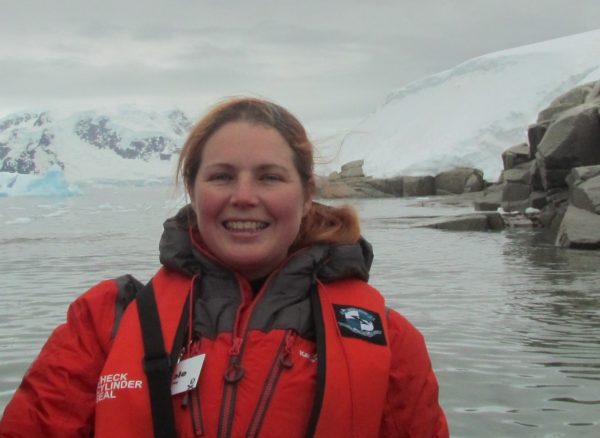 Nicole Hellessey
Nicole Hellessey
Nicole Hellessey is a PhD student with the Institute for Marine and Antarctic studies. Nicole was lucky enough to be chosen as an inaugural participant of the Homeward Bound Project in 2016 to raise awareness for women in STEM fields. Nicole is now a passionate advocate for women in science and an upcoming science communicator with the Young Tassie Scientists. When she’s not busily working on her thesis or in the lab, Nicole is a single parent and medieval enthusiast.
Nicole is researching Antarctic krill diets and how they change seasonally, inter-annually, regionally and with the environment. Nicole’s end goal is to help the krill fishery to become more sustainable by understanding when and where to harvest to maximise their omega3 outputs whilst minimising their krill catch. Nicole will be discussing the basics of krill biology and the krill fishery and how they both may change into the future. Everything from krill size and sex, to how much the fishery really harvests from the Southern Ocean will be put under the microscope and open for debate.
Shasta Henry
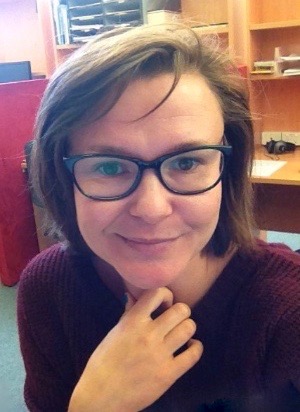 Shasta is a current PhD candidate at the University of Tasmania, where she is looking into the impact of wildfires on alpine invertebrate communities. After graduating with Honors in invertebrate ecology, Shasta interned at the Smithsonian National Museum of Natural History in Washington DC, assisting in the identification of new species of beetles from the Amazon. They even named an insect named after her.
Shasta is a current PhD candidate at the University of Tasmania, where she is looking into the impact of wildfires on alpine invertebrate communities. After graduating with Honors in invertebrate ecology, Shasta interned at the Smithsonian National Museum of Natural History in Washington DC, assisting in the identification of new species of beetles from the Amazon. They even named an insect named after her.
As a ‘Young Tassie Scientist’ she teaches school kids the difference between bugs and beetles, and how to grow up to be a scientist. As an independent Science Communicator she talks about insects as technology, on farms, under your skin and on your plate. Shasta is the entomologist on call for ABC radio Hobart and a member of the Australian Entomological Society Conservation Committee.
There are 1 million species of insects named in the scientific literature. But there are an estimated 5.5 million species of insects globally. That leaves a conservative 80% of species unnamed. Looking at insects in a quiet place like Tasmania it is likely, if not necessary, that you’ll name a species or two. A scientific name, as unique and specific as the species themselves is an international label used to file and access the knowledge we possess about any particular species. So what does that process of filing and acquisition look like when the file does not have a label; when people start stuffing papers into neighboring files or stuff has simply not been filed at all? A treasure hunt ensues! A (hopefully) thrilling account of the sleuth work involved in identifying the Tasmanian golden sun cockroach.
Peter Lynch
Peter Lynch is a graduate of the Canberra School of Music (performance), Monash University (musicology) and The University of Melbourne (education administration). He has taught at the Victorian College of the Arts, The University of Melbourne, the Melba Memorial Conservatorium of Music, and the Conservatorium of Music, University of Tasmania. From 1999 to 2008, he was Director of Murray Conservatorium, Albury. In that capacity, he established two orchestras, a number of smaller ensembles and presented numerous public concerts featuring staff and students together with recitals by many of Australia’s finest performers and composers. For forty years, Peter examined in Australia and overseas for the Australian Music Examinations Board. As a classical guitarist, he has performed, broadcast and recorded as soloist and in ensemble with some of Australia’s most highly regarded musicians. These include Prudence Davis and Jeffrey Crellin (Images) and Jane Rayner (Cloud Eight: Australian Music for Flute and Guitar). His MA thesis on Gertrude Healy, the noted Australian violinist, was recognised by way of an entry in the Australian Dictionary of Biography and he is now awaiting the outcome of the examination of his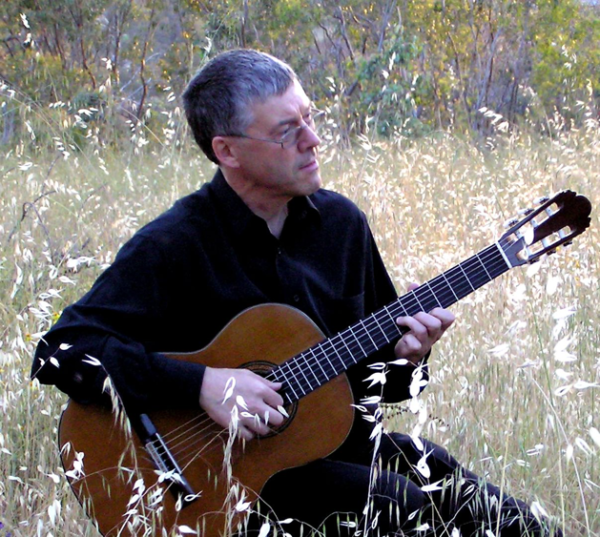 PhD on liturgical music in four Australian monastic communities. Peter and his partner Bronwyn, when not busy in their cottage garden, work in a voluntary capacity at the Catholic Archdiocese of Hobart Archives and Heritage Collection.
PhD on liturgical music in four Australian monastic communities. Peter and his partner Bronwyn, when not busy in their cottage garden, work in a voluntary capacity at the Catholic Archdiocese of Hobart Archives and Heritage Collection.
The Second Vatican Council heralded a period of immense and often unprecedented change for all Roman Catholics, particularly with regard to matters liturgical. Against the backdrop of Sacrosanctum Concilium, promulgated by Paul VI on December 4, 1963, and subsequent Vatican legislation, this research investigated, through an ethnographic methodology, the responses to the challenges and opportunities that arose through the process of liturgical reform within the Australian monastic context. The communities selected for this study were the Discalced Carmelite Nuns at the Carmelite Monastery in Kew, Victoria; the Trappist Monks at Tarrawarra Abbey in the Yarra Valley, Victoria; the Benedictine Nuns at Jamberoo Abbey, New South Wales; and the Benedictine Monks at New Norcia, Western Australia. The research focused on the liturgical music of each of these communities as it evolved over the period from 1960, two years prior to the commencement of the Council, to 2015, marking 50 years since its conclusion. It demonstrated that, through their collective commitment and the expertise of individual musicians from within their ranks as well as further afield, they resolved, to a large extent, the inherent tension between the demands of liturgical reform, particularly with regard to the vernacularisation of their liturgies and the concomitant necessity to develop sympathetic musical constructs, and the preservation of the treasury of sacred music, especially Gregorian chant. In so doing, they not only succeeded but excelled in meeting the challenge of the reform.
Dr Patsy Cameron AO – Voices from the Other Side of the Colonial Sea Frontier – 23 September 2018 – QVMAG Inveresk
Tasmania – 2018 Launceston Lecture Series
Dr Patsy Cameron AO
Voices from the Other Side of
the Colonial Sea Frontier
in the Meeting Room, QVMAG at Inveresk I
1.30 pm Sunday 23rd September 2018
Admission: $6 General Public,
$4 QVMAG Friends, members of Launceston Historical Society and Students
Free for members of The Royal Society of Tasmania
 Patsy Cameron grew up on Flinders Island and traces her Tasmanian Aboriginal heritage through her mother’s line to the northeast Coastal Plains Nation and the east coast Oyster Bay Nation. For over forty years Patsy has been a passionate champion for Aboriginal education and the promotion of cultural heritage and traditional practice. Patsy has a Bachelor of Arts with major studies in Archaeologyand Geography and a Master of Arts in Aboriginal History. Her MA thesis Grease and Ochre: The blending of two cultures at the colonial sea frontierwas published by Fuller’s Bookshop in 2011. She was inducted into the Tasmanian Women’s Honour Roll in 2006 and received a prestigious honorary Doctor of Letters from the University of Tasmania in August 2016 for her outstanding contribution to the Tasmanian community. In June 2017 Patsy was awarded an Officer of the Order of Australia (AO) on the Queen’s birthday honour list.
Patsy Cameron grew up on Flinders Island and traces her Tasmanian Aboriginal heritage through her mother’s line to the northeast Coastal Plains Nation and the east coast Oyster Bay Nation. For over forty years Patsy has been a passionate champion for Aboriginal education and the promotion of cultural heritage and traditional practice. Patsy has a Bachelor of Arts with major studies in Archaeologyand Geography and a Master of Arts in Aboriginal History. Her MA thesis Grease and Ochre: The blending of two cultures at the colonial sea frontierwas published by Fuller’s Bookshop in 2011. She was inducted into the Tasmanian Women’s Honour Roll in 2006 and received a prestigious honorary Doctor of Letters from the University of Tasmania in August 2016 for her outstanding contribution to the Tasmanian community. In June 2017 Patsy was awarded an Officer of the Order of Australia (AO) on the Queen’s birthday honour list.
Most accounts of early contact relations between the Straitsmen and their Aboriginal wives, with whom they made homes on the small islands of Bass Strait during the first decades of the 1800s, are permeated with characterisations of slavery and savagery. Much of the colonial record was written from afar, and many who did observe the sea frontier at close quarters had reasons to present biased viewpoints. This presentation, at stark counterpoint to those white masculine colonial narratives that pervade understandings of Tasmanian Aboriginal history, allows the voices of Islanders from the other side of the sea frontier to finally be heard.
![]() GENEROUSLY SUPPORTS THE PRESENTATION OF THIS LECTURE
GENEROUSLY SUPPORTS THE PRESENTATION OF THIS LECTURE
“And so to bed…” Susannah Fullerton
This lecture by Susannah Fullerton OAM will take place on Wednesday, 14 November 2018 at 8:00 pm in the Central Gallery of TMAG, Hobart
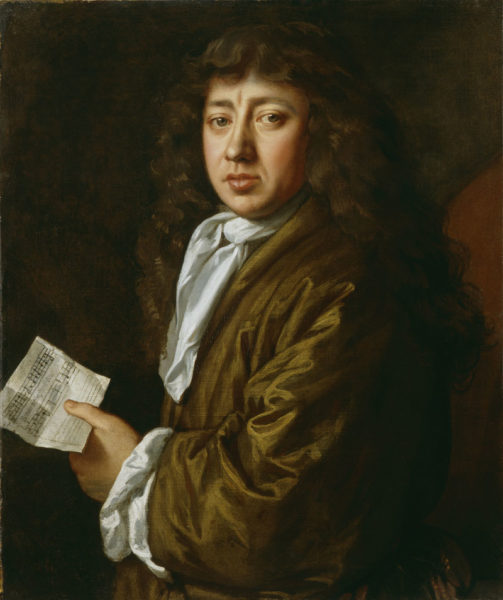
Samuel Pepys by John Hayls, c.1666 (National Portrait Gallery, London)
The diary of Samuel Pepys (1633-1703) has long been considered the greatest diary in the English language. Historians have found it invaluable, but it is also a superb work of literature and the record of an extraordinary man.
Founder of the modern English navy, President of the Royal Society, Member of Parliament, author of books on the navy, talented musician and composer and lover of a very large number of women, Samuel Pepys delighted in many aspects of Restoration London and recorded them all in his diary.
“And so to bed …”, Susannah Fullerton’s talk on Pepys, tells of his experience of the Plague and the Great Fire, his constant womanising, his theatre-going and his dinners. Susannah loves to share her enthusiasm for this most human and delightful of diarists.
Please note the special time of Wednesday 14th of November for this lecture.
Further information can be found on Susannah’s website
here:-
And so to bed …
♠
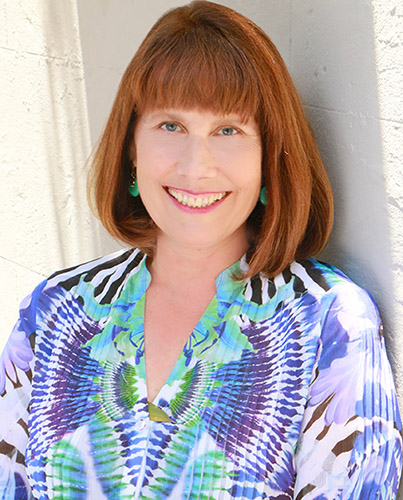
Susannah Fullerton, OAM, FRS(N), has been president of the Jane Austen Society of Australia, this country’s largest literary society, for the past 22 years. She is the author of several books on Jane Austen and gives many talks around the world about her favourite novelist.
Susannah also gives talks at libraries, schools, the Art Gallery of NSW and State Library of NSW on many other famous writers, such as Pepys, Oscar Wilde, the Brontës, Dickens, Trollope and many more. She has written Brief Encounters: Literary Travellers in Australia about famous authors visiting Australia, and has also written and recorded two audio CDs, Finding Katherine Mansfield and Poetry to Fill a Room. Susannah also leads literary tours to the UK, France, Italy, Scandinavia, NZ and America for Australians Studying Abroad.
Rise of the Drones: how Unmanned Aircraft Systems create new opportunities for environmental remote sensing and geosciences
Tuesday 4th September 2018, 8:00 pm – The Royal Society Room, TMAG, Hobart
In recent years, the increased use of ‘drones’ in civilian applications has received both positive and negative coverage in the media. Many find the thought of flying robots that ‘invade’ people’s lives or pose risks to passenger airplanes too intimidating and unacceptable. However, this presentation will show that drones (preferably termed Unmanned Aircraft Systems or UAS) fill a novel and exciting niche when it comes to observing, mapping, and monitoring the environment at unprecedented levels of detail.
The TerraLuma research project at the University of Tasmania has developed novel tools and algorithms for environmental remote sensing applications and aerial surveys using UAS. We have worked on a range of applications, including precision agriculture and viticulture; mapping and monitoring vegetation in remote locations such as Antarctica; deriving 3D tree structure for forest inventories; landslide deformation monitoring; 3D stock pile and quarry surveys and volume estimations; assessment of coastal erosion; mapping of geological structures; better understanding functions of natural vegetation communities such as saltmarshes; transforming images into knowledge.
Associate Professor Lucieer will give an overview of the technology and exciting applications of UAS remote sensing. I will share our practical field experiences, our ups and downs, dos and don’ts from the last nine years of operating UAS for remote sensing research.
Arko Lucieer is an Associate Professor in Remote Sensing at The University of Tasmania, Australia. He leads the TerraLumaresearch group, focusing on the development and application of unmanned aircraft systems (UAS), sensor integration, and image processing techniques for environmental, agricultural, and high-precision aerial mapping applications. Arko teaches remote sensing and GIS at the undergraduate and graduate levels. He obtained his PhD degree in 2004 from the International Institute for Geo-Information Science and Earth Observation (ITC) and Utrecht University in The Netherlands. His current focus is on quantitative remote sensing of vegetation with the use of sophisticated UAS sensors to better understand the structure, distribution, and functioning of vegetation, and to bridge the observational scale gap between field samples and satellite observations.
Associate Professor Arko Lucieer
Geography and Spatial Sciences, School of Technology, Environments and Design
College of Sciences and Engineering, UTAS
The Royal Society of Tasmania Medal Presentation and Lecture – Government House – 6.00 pm, Thursday 30 August 2018
PLEASE NOTE: TICKETING FOR THE MEDAL PRESENTATION AND LECTURE HAS NOW CLOSED.
Members and friends are invited to attend The Royal Society of Tasmania Medal Presentation and Lecture, to be hosted at Government House by Her Excellency Professor the Honourable Kate Warner, AC, Governor of Tasmania. and Mr Warner at 6.00pm on Thursday 30 August 2018.
The recipient of the medal and lecturer is Emeritus Distinguished Professor Ross Large.
The Royal Society of Tasmania Medal was established in 1927 and is the most prestigious award conferred by the Society.
≈
The Rhythms of Earth and Life Through Time
Earth has a pulse called plate tectonics and this pulse has controlled the formation of great mountain ranges, the chemistry of the oceans and the evolution of life over the last four billion years. The formation and break up of supercontinents, the supercontinent cycle, involves continental plates crashing together to build major mountain ranges. This process, in geological terms, was slow to get underway, occurring roughly every 400 to 600 million years in the early stages of Earth history.
However, about 600 million years ago, the plate tectonic and mountain building process sped up to a frequency of 60 to 120 million years. This change in the rhythms of Earth processes was fundamental to the evolution of life, starting with the Cambrian explosion at 550–520 million years ago, followed by cycles of rapid bio-diversification, then mass extinction.
Five cycles driven by plate tectonics and mountain building took place over the last 600 million years, each commencing with diversification of life and ending in a major mass extinction event. These constitute the rhythms of Earth and life.
Ross Large is an Emeritus Distinguished Professor of Geology at the University of Tasmania. He gained his BSc (Hons) from the University of Tasmania in 1969, PhD from University of New England in 1973 and an Honorary Doctor of Engineering from the University of Lulea, Sweden.
For ten years Ross worked in the mineral exploration industry. In 1984, he joined the University of Tasmania and, five years later, established the Centre for Ore Deposit and Exploration Science (CODES). Under his leadership, CODES grew to become recognised as one of the top industry collaborative ore deposit research centres in the world.
Ross has published over 120 scientific papers and is internationally recognised for his research on the genesis of ore deposits and relationships to Earth evolution. His current research interest is the chemistry of past oceans and relationships to evolution of life, mass extinction and mineral deposit cycles.
He has won many awards during his career – the most recent as lead scientist for a UTAS team that won the 2016 Eureka Prize for interdisciplinary research. Ross is the President of The Royal Society of Tasmania and the Chair of the Tasmanian Division of The Academy of Technology and Engineering.
≈
You can hear Ross talking about his research on ABC Radio Hobart Breakfast with Ryk Goddard.
≈
Booking information:
We invite you to register to attend The Royal Society of Tasmania Medal Presentation and Lecture at Government House at 6.00pm on Thursday 30 August 2018.
All attendees will need to book and print their tickets by Friday 17 August 2018.
The bookings for this event will open on Wednesday 1st August and close on Friday 17 August 2018.
There is no charge to obtain a ticket and these may be booked via the Government House website as follows:
- Go to http://www.govhouse.tas.gov.au and click on the ‘Events and Tours’ tab on the right-hand side of the homepage. Select ‘Reserve tickets’ for The Royal Society of Tasmania Medal Presentation & Lecture. You will be directed to the Government House Tasmania event on the http://Trybooking.com website.
- Enter the Invitation Code: RSMP18. This will allow you access to continue your booking via the Trybooking website.
- Complete the booking as per the Trybooking website instructions. Tickets should be booked in the names of the guests who wish to attend. Generic bookings, such as “Partner of Mr Bill Smith”, are NOT acceptable. In the ‘‘Capacity in which attending” box, we would be grateful if your guests would indicate the capacity in which they will be attending the reception, e.g: Organising Committee, Board Member, Member, etc. Ticket(s) will be sent to the guest’s nominated email address.
- Guests will need to print their ticket(s) and ensure that they bring it/them to Government House on the evening or, alternatively, the ticket(s) can be scanned from a mobile phone.
- The closing date for bookings is Friday 17 August 2018 (6.00 pm).
We look forward to seeing you there.
David Wilson
Honorary Secretary
Associate Professor Jonathan Binns – Why does an Engineer need a PhD? – Sunday 26 August 2018, 1.15 pm, Meeting Room, QVMAG Inveresk, Launceston
The program will commence with reports by Rose Donnelly (Year 12) and Dominic Grosewill (Year 10) on their experiences at the 2018 London International Youth ScienceForum and the YouthConference of the Australian & New Zealand Association for the Advancement of Science.
This will be followed by Professor Binns’ lecture on the role of research in the diverse and complex disciplines in engineering.
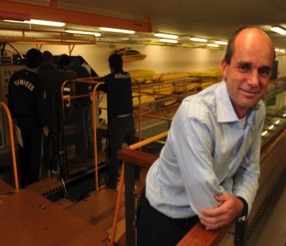 Engineering is an inherently applied set of disciplines. As such research and development often involves little “r” and big “D”. However, the definition of engineering from Engineers Australia is stated as “Engineers arescientists, inventors, designers, builders and great thinkers. They improve the state of the world, amplify human capability and make people’s lives safer and easier.” Improving human capability requires research, research requires research training. To fulfil the expectations of engineering we need to have R&D Engineers qualified with PhDs. Jonathan will explain high level R&D from engineers in fast ferry design, submarine analysis and America’s Cup technology.
Engineering is an inherently applied set of disciplines. As such research and development often involves little “r” and big “D”. However, the definition of engineering from Engineers Australia is stated as “Engineers arescientists, inventors, designers, builders and great thinkers. They improve the state of the world, amplify human capability and make people’s lives safer and easier.” Improving human capability requires research, research requires research training. To fulfil the expectations of engineering we need to have R&D Engineers qualified with PhDs. Jonathan will explain high level R&D from engineers in fast ferry design, submarine analysis and America’s Cup technology.
Jonathan has trained and worked as a design and research engineer. His primary expertise is in a variety of model and full scale experiments as well as numerical flow predictions. He has experience in hydrodynamic and structural design, research, development and simulation of marine craft.
Jonathan has taken a leading role in research across the whole of the Australian Maritime College in his roles as Associate Dean of Research and Director of the ARC Research Training Centre for Naval Design and Manufacturing (RTCNDM). The RTCNDM is a training centre whose mission is to create a new cohort of PhD trained engineers for the naval design, manufacturing and sustainment of a global supply chain.
GENEROUSLY SUPPORTS THE PRESENTATION OF THIS LECTURE
Prof Margaret MacMillan – War and the Making of the Modern World
Friday 10th August 2018, 6:00 pm – Stanley Burbury Theatre UTAS, Hobart
War is deeply woven into human history. Organised society and conflict appear to have marched side by side, each affecting the other. Wars have changed societies in many ways but changes in society have also affected the nature of war. We remember war, rightly, for its destructive impact but it has also led to advances in science, to improvements in the position of previously marginalized groups such as women, or to greater equality. This lecture will examine some of the paradoxes of war drawing on examples from history. Since it is a century since the end of the Great War particular attention will be paid to its causes and consequences.
Professor Margaret MacMillan is a Canadian historian at the University of Toronto and professor of International History at Oxford University, as well as a leading expert on history and international relations.
Professor MacMillan was educated at the University of Toronto and Oxford University. Her doctoral dissertation was on the social and political perspectives of the British in India. She is former provost of Trinity College at the University of Toronto and was a member of the History Department of Ryerson University in Toronto for 25 years. She is the recipient of numerous literary awards for her book Peacemakers: The Paris Peace Conference on 1919 and its Attempt to End War.
MacMillan’s research has focused on the British Empire in the later 19thand early 20thcenturies and on international relations in the 20thcentury. She has served on the board of the Canadian Institute for International Affairs, the Atlantic Council of Canada, the Ontario Heritage Foundation, and the Churchill Society for the advancement of Parliamentary Democracy (Canada). She is a Fellow of the Royal Society of Literature, an Honorary Fellow of St. Antony’s College, Oxford, and a Senior Fellow of Massey College, University of Toronto. She is a Companion of the Order of Canada and a Companion of Honour (Commonwealth Realms).
Professor MacMillan’s publications include: Women of the Raj:The Mothers, Wives, and Daughters of the British Empire in India; The Uses and Abuses of History(based on the 2008 Joanne Goodman lecture series); The War that ended Peace: how Europe abandoned Peace for the First Word War; and History’s People: Personalities and the Past (based on the 2015 Massey Lectures).
Professor MacMillan recently delivered the 2018 Reith lectures series, originally broadcast on BBC Radio4 and now being broadcast on ABC Radio National “Big Ideas” program. You can listen to podcasts of the series here:
1. War and Humanity
2. Making Sense of the Warrior
3. Civilians and War
Presented in partnership with the High Commission of Canada, the University of Tasmania and the Tasmanian Museum and Art Gallery.
Dr Andrew Cole – A New High-Precision Look at the Milky Way
TMAG Customs House, Hobart Tuesday 3 July @8 pm
All are welcome, free lecture.
In the past decade the field of astronomy has been building towards a revolution in the way we measure distances and other fundamental physical properties of the stars in our home galaxy, the Milky Way. The rapid increase in detector sensitivity and computing power in the 21st century has enabled both ground-based and space-based astronomy missions to survey enormous areas of the sky with unprecedented precision in the astrophysical parameters.
Andrew will discuss some of the most significant recent developments to come out of this “big data” revolution, which range from improved knowledge of the frequency and masses of planets around nearby stars, the distribution of luminous and dark matter in the Milky Way, and the forensics of working out how the galaxy itself was assembled by infalling matter over billions of years.
Dr Andrew Cole is Associate Professor in Physics and Astronomy and the Director of the Greenhill Observatory, the home of UTAS optical astronomy research infrastructure. Dr Cole studies the processes and effects that govern the evolution of matter in the Universe from the Big Bang to the present day. Essentially, how things came to be from the beginning of time as we know it. Along with many who came before him and undoubtedly many to follow, he is driven by an innate curiosity, stubbornness and a sense of adventure. Dr Cole uses the UTAS 1.3-metre Harlingten telescope to search for exoplanets around stars in the direction towards the centre of the Mil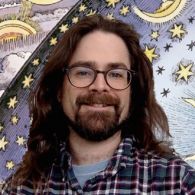 ky Way by analysis of gravitational microlensing light curves.
ky Way by analysis of gravitational microlensing light curves.

